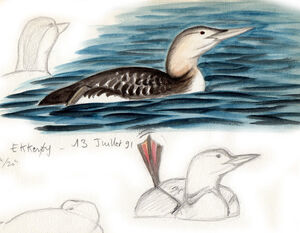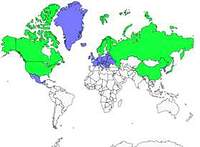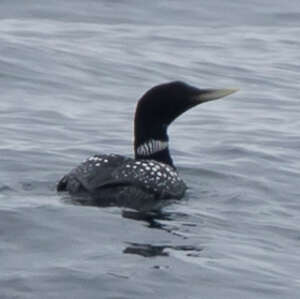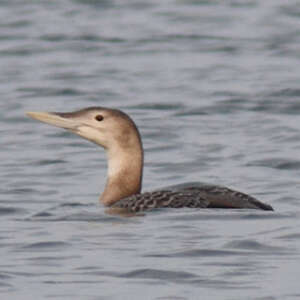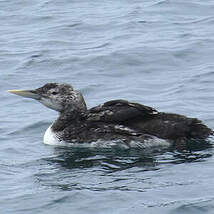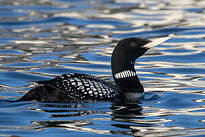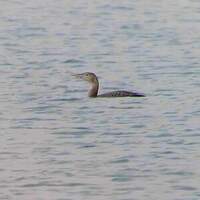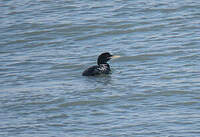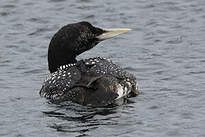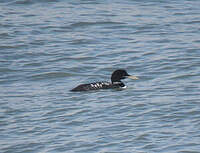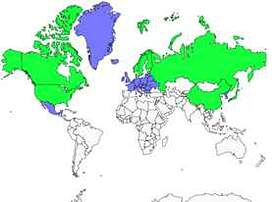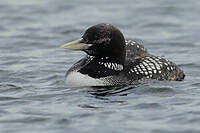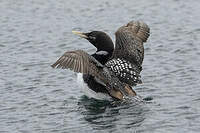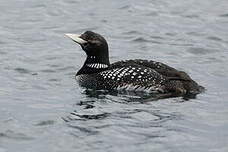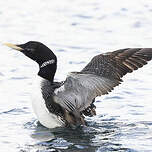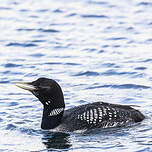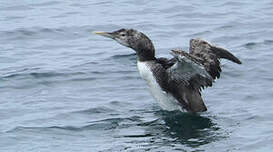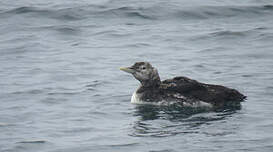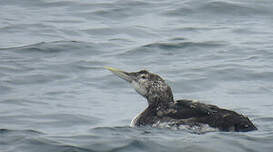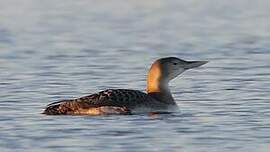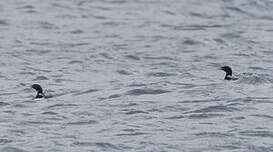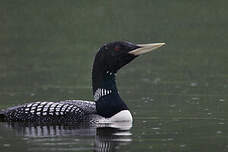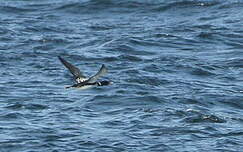Yellow-billed Loon
Gavia adamsii - Plongeon à bec blanc
Identification
The largest of the Loons, the Yellow-billed Loon's size can often be underestimated from a distance if it is not compared to other species. Its silhouette can be misleading. In all plumages, it is easily distinguishable by the colour of its beak and the posture of its head when resting on water; the beak is always pale, yellow-straw in breeding plumages and pale yellow to subtle blue shades in juvenile plumages. Furthermore, the beak is held upward so that the culmen appears horizontal or even slightly raised, and the lower mandible is prominently raised. Identification does not pose a problem if the bird is within a reasonable distance, otherwise it could be problematic.
The breeding plumage is highly contrasting - typical of the genus - with a black-and-white chequered mantle and longitudinal stripes on the lower neck. However, one must be on the breeding grounds to hope to observe it.
The winter or juvenal plumage is the one generally observed. It is overall paler than that of the Red-throated Loon, particularly in the head and neck where the contrast between the dark top and white bottom is not clearly seen. It can be distinguished from the adult in winter by its clear mesh mantle coloring. When size cannot be assessed, confusion can come up with the Red-throated Loon which presents the same paleness, head posture, but a much finer beak. Finally, the forehead of the Yellow-billed Loon is bumpier than that of the Red-throated Loon.
Subspecific information monotypic species
Foreign names
- Plongeon à bec blanc,
- Colimbo de Adams,
- mobelha-de-bico-amarelo,
- Gelbschnabeltaucher,
- fehércsőrű búvár,
- Geelsnavelduiker,
- Strolaga beccogiallo,
- vitnäbbad islom,
- Gulnebblom,
- potáplica bielozobá,
- potáplice žlutozobá,
- Hvidnæbbet Lom,
- jääkuikka,
- calàbria de bec pàl·lid,
- Svalbrúsi,
- nur białodzioby,
- dzeltenknābja gārgale,
- rumenokljuni slapnik,
- Белоклювая гагара,
- ハシジロアビ,
- 黄嘴潜鸟,
- vitnäbbad islom,
- 白嘴潛鳥,
Voice song and call
The Yellow-billed Loon's vocalizations are only present during its breeding season. Its song, audible in its Arctic breeding grounds, is similar to the Mew Gull's. Adults make plaintive howls that vary in tone and can be heard for miles on the surface of the water. The presence of the birds is noticed at this time. Various cries can also be heard. While in territorial flight, the bird emits a rapid sequence of notes resembling the call of a Curlew, but much louder.
Habitat
Like all of its peers, the Yellow-billed Loon cannot move on dry land and is thus strictly aquatic, coming ashore only to nest. During breeding season, it mainly occupies water bodies of the tundra rich in food and freed of ice, but also rivers, estuaries and deltas, and locally the sea itself. During the non-breeding period, the population is found in the sea due to the freezing of fresh water in the tundra.
Behaviour character trait
This Yellow-billed Loon is known to be rare, and its distribution is irregular across the large area that it occupies during the summer season. Very territorial during reproduction, it then becomes gregarious like the other loons. It is an excellent diver, diving with ease due to the large size of its palmed fingers, immersing itself without making a wave by using its body density.
Flight
Dietfeeding habits
The Yellow-billed Loon is, according to the literature, essentially piscivorous. But it also feeds on crustaceans when they abound. This has been observed, for example, at the Lake of Der in Champagne, which has already welcomed it at least twice. The loons of the four species almost exclusively fish for non-native crayfish there.
Reproduction nesting
They arrive at their breeding grounds from the tundra in mid-June only, when the waters are free. The nest is built right at the edge of the water, on an island if possible for protection from predators land. By late June or early July, the female lays 1 or 2 eggs that will be incubated for 25 days. The nestlings, nidifuges, leave the nest for the water at birth.
Geographic range
This is a species of the high Arctic, with a circumboreal distribution. It breeds on the Arctic ocean from Murmansk and southern New Zemlya in Russian Arctic to the Mackenzie River in Canadian Arctic via the Bering Strait. It is a rare nester in European Russia, with a stable population of a few tens of pairs. The wintering area is wider, extending west along the Atlantic coast as far north as the polar circle. Varangerfjord in Norway is known to regularly host a small number. Most of the population remains in the Arctic waters in winter. Some individuals, mostly juveniles, however, venture further south to the latitudes of France, mostly on the coast but also exceptionally on large interior water bodies.
Threats - protection
Sources of information
- IOC World Bird List (v14.2), Gill, F and D Donsker (Eds). 2024-04-18.
- An Atlas of the Birds of the Western Palearctic, Colin Harrison
- xeno-canto, Sharing bird sounds from around the world,
Other sources of interest
 Specification sheet created on
27/07/2023 by Jean François
Specification sheet created on
27/07/2023 by Jean FrançoisTranslation by AI Oiseaux.net
© 1996-2025 Oiseaux.net
- Accipitriformes
- Aegotheliformes
- Anseriformes
- Apodiformes
- Apterygiformes
- Bucerotiformes
- Caprimulgiformes
- Cariamiformes
- Casuariiformes
- Charadriiformes
- Ciconiiformes
- Coliiformes
- Columbiformes
- Coraciiformes
- Cuculiformes
- Eurypygiformes
- Falconiformes
- Galliformes
- Gaviiformes
- Gruiformes
- Leptosomiformes
- Mesitornithiformes
- Musophagiformes
- Nyctibiiformes
- Opisthocomiformes
- Otidiformes
- Passeriformes
- Pelecaniformes
- Phaethontiformes
- Phoenicopteriformes
- Piciformes
- Podargiformes
- Podicipediformes
- Procellariiformes
- Psittaciformes
- Pterocliformes
- Rheiformes
- Sphenisciformes
- Steatornithiformes
- Strigiformes
- Struthioniformes
- Suliformes
- Tinamiformes
- Trogoniformes

